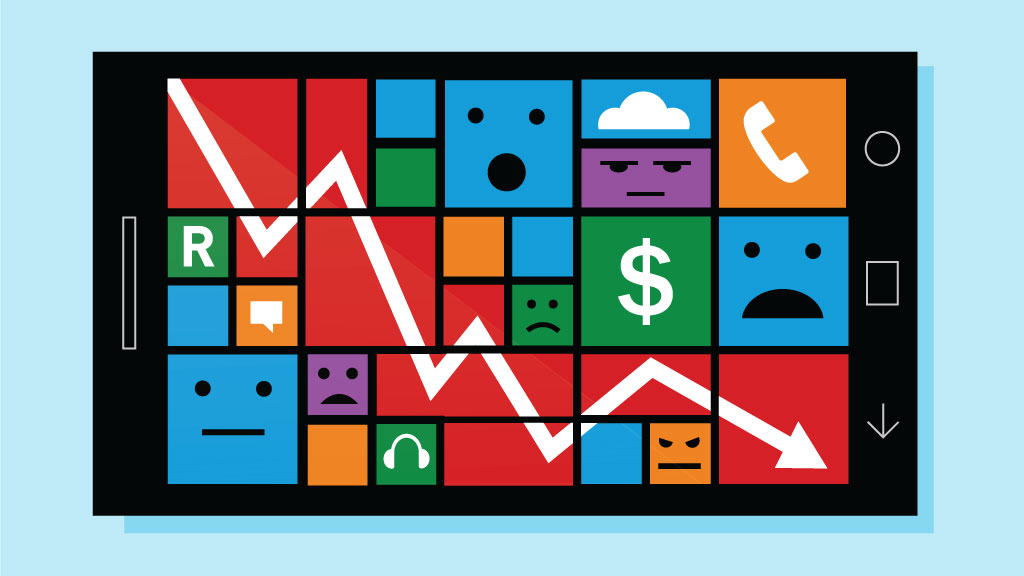Windows Phone: The Writing On the Wall
by Dev Sheth | published Feb. 26th, 2016
Usually when an ambitious multi-billion dollar corporation doesn't make the top-five list of the market share for a key product some wholesale changes are in order. This isn't so at Microsoft.
The final quarter of 2015 estimated Windows phone sales at 4.5 million devices, resulting in a staggering 49 percent drop in revenue from the same period in 2014 when 10.5 million Windows phones were sold. During the same period overall mobile device sales grew by 5.7 percent, according to International Data Corporation (IDC) reports. Clearly other vendors are pulling away from Microsoft, so its persistence in marketing its mobile devices is confusing.
| Vendor | Q4 sales - 2015 | Q4 sales - 2014 | Year-over-year growth |
|---|---|---|---|
| Samsung | 85.6 millions | 75.1 millions | 14.0% |
| Apple | 74.8 millions | 74.5 millions | 0.4% |
| Microsoft | 4.5 millions | 10.5 millions | -57.1% |
| Total | 399.5 millions | 377.8 millions | 5.7% |
The key problem for Microsoft remains transitioning to a mobile-centric approach that isn't reliant on Windows phones. Forbes notes that Microsoft CEO Satya Nadella has pushed Microsoft along that path, moving away from focusing on its hardware platforms and on to its cloud-based services geared towards mobile devices. This is also reflected in the wildly popular Surface devices making its way through the tablet market.
Whether by accident or by design, Microsoft has found the winning formula with the Surface series.
Light-weight, portable tablets appear to be the future of mobile computing and that market remains sparsely populated. iPads are the strongest competitors to the Surface series, but Microsoft has turned the tables on Apple by persisting with designing an operating system that works uniformly across all three device markets — mobile, tablet and desktop.
Granted, that approach didn't work the first time around. In the days before Windows 8, Microsoft supplied the Windows Mango OS for Nokia's Lumia series. Gireeshma Reddy, a second year RIT graduate student in the Department of Computer Science, used a Nokia Lumia 800 running Windows Mango from 2012 to 2014.
"The (Lumia) 800 was a sleek device," Reddy said. "The music app worked better than the current ones on Android, in my opinion. It had Office on device, which was rare back then, but app updates were a major issue, usually updating months after their counterparts on iOS and Android. Once Windows 8 was released, that stopped as well."
Microsoft seems to have learnt its lessons this time. Agastya Chowdhary, a second year RIT graduate student in the Information Sciences and Technologies program used a Lumia 640 running Windows 8.1 until this February.
"The device felt beautiful and all apps ran smoothly," Chowdhary said. "I've been using the Surface Pro 4 for the past two months and the user experience is more or less uniform across the Lumia and the (Surface) Pro. The in-built apps like Groove Music and Movies & TV are quite good but they just aren't as popular as Netflix, Amazon and the rest. The app store isn't as populated as Apple's App Store or Google's Play Store either but the apps that are available have worked great."
It would seem that app support might still be a problem for the new devices. Chowdhary, however, is optimistic and for a good good reason. He studies app development and has been working on hybrid apps that work across all platforms, including Windows 10.
"The application development platform for Windows 10 is far superior to the one for Windows 8," Chowdhary said. "It has fewer bugs and works far better than the previous version. It should lead to more of the popular apps coming to Windows in the future."
Microsoft might just be hoping for the same.



